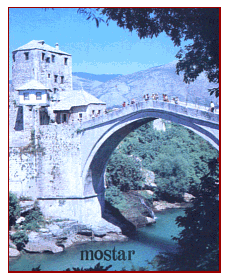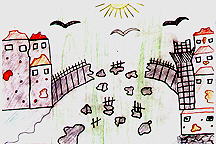|
The Old Bridge in Mostar
In the spring of '85 Ramona and I spent 15 days traveling throughout the country known then as Yugoslavia (Union of Slavic Nations) with the Friendship Force. Eight years later I was to see on television, the very hotel we stayed at in Sariavo, destroyed by gunfire and bombing of that beautiful city. Apartment complexes built during the winter Olympics that would house hundreds of families, who on the average had to wait fifteen years before leaving their parents home after marriage, were now leveled. All of this saddened me but none of it brought tears as I sat safely in the security of my TV room.
My parents didn't come from Yugoslavia, I know no-one personally who has even visited there as we did, but I can't seem to understand how hatred can run so deep that a beautiful bridge in the mountains of Bosnia that had withstood centuries of war from aggressive peoples outside its borders was now destroyed by peoples within its borders. In the lovely city of Mostar I walked what in recent years was known as "Stari Most" which means "the Old Bridge". A narrow stone structure, peaked in the middle, with steep inclines on both sides that would make walking difficult were it not for the raised stones spanning its width at frequent intervals. This, I was told, was done so horses would not slide down the slippery stone surfaces. It was narrow and certainly was not adequate for modern day travel. But I envisioned it being placed over the river much the way a child would slightly fold a piece of cardboard and set it across two tables so he could walk his fingers from one table to the other. The Neretva river below it flowed gently over massive rocks that lined the shore far below. It was by far, the most beautiful bridge I had ever seen. Without the pins and bolts and columns that are seen in other bridges, I sensed a magical hand holding it so the sheer beauty would not disappear in the gorge below. The structure was built in the 16th century by an architect by order of the Turkish Sultan "Suleyman the Magnificent". As the story goes, bridge construction at that location had been attempted once before and had failed. The Sultan told the second architect that he would not fail lest he be put to death. The work took nine years. Lime stone blocks were "Pasted" together using egg and egg shell. The adhesiveness and quick drying of the mixture would allow the workers to span the area until the structure itself would keep it together. When completed the architect lacked confidence in his own work and thus fled the area in the hopes of avoiding what he felt would be sure death. Now, more than 400 years later, the structure could resist all but the wrath of the people who benefited most from it.
Return to Intro
|
||
![]()

 I didn't know Yugoslavia well. I only
visited it and its people once and that was for only a few
days, but within that period I was exposed to an area of the
world that was not only diverse in its landscape, it was
obvious, even before the demise of the Soviet Union, that the
peoples in different parts of the country disliked and
distrusted each other. The culture was markedly different
everywhere we visited.
I didn't know Yugoslavia well. I only
visited it and its people once and that was for only a few
days, but within that period I was exposed to an area of the
world that was not only diverse in its landscape, it was
obvious, even before the demise of the Soviet Union, that the
peoples in different parts of the country disliked and
distrusted each other. The culture was markedly different
everywhere we visited.
 Only when I heard about a bridge that was destroyed in the
city of Mostar did I realize how tragic were the differences
I had experienced. And I cried.
Only when I heard about a bridge that was destroyed in the
city of Mostar did I realize how tragic were the differences
I had experienced. And I cried.
 As I think back and I stare endlessly at the pictures and
drawings that fill the walls of my Family Room, I cannot
imagine the area I visited without the "Old Bridge".
There is no image where the bridge once stood. The area
behind the bridge is not water, land bank or building. It is
like a black hole, a once was and now isn't, a death where
memories will only last as long as those who experienced the
structure still live. And then another part of the world will
be lost forever.
As I think back and I stare endlessly at the pictures and
drawings that fill the walls of my Family Room, I cannot
imagine the area I visited without the "Old Bridge".
There is no image where the bridge once stood. The area
behind the bridge is not water, land bank or building. It is
like a black hole, a once was and now isn't, a death where
memories will only last as long as those who experienced the
structure still live. And then another part of the world will
be lost forever.